MN Pest Control | Ants
Ants are social insects that belong to the same order as the wasps and bees. They are of particular interest because of their highly organized colonies or nests which sometimes consist of millions of individuals. Ant societies have division of labor. Individuals are divided into workers, soldiers, drones and queens and colonies can occupy and use a wide area of land to support them. Ant colonies are sometimes described as super organisms because the colony appears to operate as a single entity.
Ants Are Everywhere!
Ants have colonized almost every landmass on Earth. Some of these amazing insects are hunters. Some are harvesters. Some farm fungi. Some keep slaves. Others keep caterpillars or aphids. Scientists have identified more than 11,000 species of ants worldwide. Minnesota alone has more than 100 ant species.
Most kinds of ants make their homes in tunnels in the soil or in wood. They live and work together in communities made up of hundreds or thousands of individuals, almost all of them sisters. Scientists think the world has about 10 quadrillion ants. Lets face it, that is a whole lot of ants!
Ants, live in large communities where they depend upon each other for the survival of the entire colony. Ant colonies generally form underground nests comprised of chambers and interconnecting tunnels where ants store food, lay eggs, and maintain nurseries. There can be tens of thousands of ants in a single colony and several colonies inhabiting the soil or landscape surrounding a property. For that very reason, ants can be a particularly difficult pest to eradicate. Only a handful of species around the region are known to invade homes and buildings including:
Carpenter Ants
Carpenter ants get their name because they excavate wood in order to build their nests. Their excavation results in smooth tunnels inside the wood. Carpenter ants range in size from one-quarter inch for a worker ant to up to three-quarters inch for a queen.
Odorous House Ants
The odorous house ant gets its name from the strong, rotten coconut-like smell it gives off when crushed. These tiny insects range in size from one-sixteenth of an inch to one-eighth of an inch long.
Pavement Ants
Pavement ants get their name because they make their nests in or under cracks in pavement. They can infest structures.
All ants share one primary task, to protect and care for the colony. In order to accomplish this, ants require food, moisture and shelter. A colony of ants may range from a few dozen to tens of thousands. Ant nests are commonly found outside under wood piles, flagstone or brick patios, and under rocks and garden stones.
Ants in the house may nests in wall voids, behind insulation, or in or around wood previously damaged by moisture. You are most likely to find ants in the kitchen or invading your property elsewhere when they are foraging for food. Foraging ants account for only a small percentage (typically 10% or less) of the colony’s size and it is important to understand that ants will travel extremely long distances in search of food or harborage. Once these foragers locate and establish a source of food, ants will produce a scent trail (by way of pheromones) leading to and from the nest. This pheromone trail provides direction for the ants to follow between the nest and food source. This is why you will often see ants, like the Odorous House Ant, marching back and forth along one line with little or no deviation.
Carpenter Ants
Carpenter ants are one of the most common ants found in Minnesota. They are also one of the most difficult to control.
The first indication that you may have a carpenter ant problem is by spotting large, black ants in or around your home. In many cases, you may only see a handful of ants over several days. Another sign of carpenter ant activity is the small piles of sawdust they leave behind as they tunnel their way through wood. This debris, known as “frass”, will collect beneath the site of the nest and oftentimes will include bits of dead insects. Carpenter ants are generally black, red or brown or a combination of red and black. The workers in a colony can range from 1/8th of an inch to 1/2 of an inch in length with the queen reaching nearly 1 inch in length.
Carpenter ants are not typically thought of as dangerous and generally do not bite; the real concern with an infestation of carpenter ants is with their ability to damage and weaken the structural integrity of your home.
Some do-it-yourself products may provide short term relief, but may in fact, make a problem worse. Ants are easily repelled by some common residual remedies and, without finding the colony, their repeated use can often cause a colony to move or even split into multiple colonies. And simply killing foraging ants will not eliminate the colony since the queen remains in the colony and her sole purpose is to lay more eggs to ensure the survivability of the colony.
The best way to control carpenter ants is to find and destroy the nests. This is often easier said than done. What you need is a Minnesota Pest Control Expert who will locate the nest location(s) and eliminate all the ants.
To most homeowners, all ants look pretty much alike. In truth, each have unique characteristics which may influence the method of control.
Identification of the particular species of ant is vital to implementing a control program. At Eco Tech we have been dealing with these annoying pests for 15 years. We are able to tell the difference in ant species. Also, we are well trained in locating their nesting location and terminating the colony in a timely manner.






